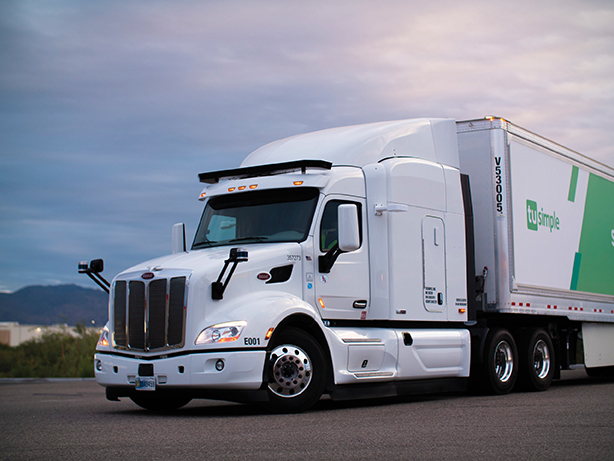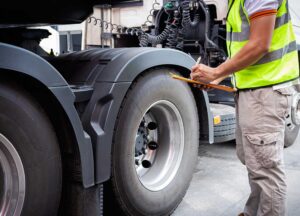When it comes to autonomous vehicles, we’re in Level 3, almost to Level 4. That’s according to the Society of Automotive Engineers (SAE) “J3016 Levels of Driving Automation” table, which defines the steps going from total human control (Level 0) to total machine control (Level 5).
Back in the 1990s, when trucks first came out with automated features such as blind-spot warnings, the driver was required to react. All the “system” could do was beep, vibrate or light up a warning light (or all of the above). That was Level 0.
At Level 3, drivers have access to devices that steer, brake, accelerate and shift gears for the vehicle. They make the job easier, but the driver must be ready at all times to take over driving duties. Typically, these features are used on the open highway under good driving conditions, with the driver resuming control when leaving the interstate.
Currently, testing is being done by multiple manufacturers on Level 4 trucks. These are trucks that can be programmed to drive themselves from point A to point B. Drivers won’t be needed — BUT the vehicles will only drive themselves under limited conditions. These vehicles may eventually still be equipped with steering wheels and floor pedals so they can be driven manually, or they may simply shut down when they can’t operate.
At the present, floor pedals, steering wheels and real, human drivers are still present in these automated vehicles, just in case.
Level 5 will happen when trucks can drive themselves in any conditions. So, how soon will drivers lose their jobs to robot trucks?
“My cousin who’s 24, is a truck driver, and I tell him that he will (be able to) retire as a truck driver if he wants,” said Robert Brown, head of government relations and public affairs at San Diego, California-based Tu Simple. “The technology is truly transformative and exciting, but it isn’t a threat to anyone’s livelihood.”
In partnership with United Parcel Service (UPS), Tu Simple is testing 40 autonomous trucks on routes in Arizona, New Mexico and Texas.
“We currently run trucks from the UPS Phoenix facility to Tucson, then to El Paso, Houston and Dallas, the Texas triangle,” Brown explained in an exclusive interview with The Trucker. “Depending on the route, some trucks drive all the way to the distribution center; some get close and the driver takes control.”
Those trucks are manned by experienced drivers, who are hired for more than their driving ability.
“We hire 20- and 30-year veterans to come to Tu Simple,” Brown said. The testing involves learning so that automated systems can react to conditions that could vary every time out. Experienced drivers can point out incidents where the truck didn’t react properly or could have performed better, and the developers can tweak the system. It’s an ongoing process, but it won’t be long before testing gives way to actual use.
When will this happen?
“We’re looking at a 2024 to 2025 time period when it will get interesting,” Brown said. “That’s when an OEM will build a completely autonomous truck that’s Level 4 capable.”
Once autonomous trucks are available for purchase, carriers will begin finding routes where they add value. “Implementation of Level 4 trucks will be regional, route specific and gradual,” Brown added.
One reason for that is the quagmire of state and local laws and regulations. Each jurisdiction, in its own time, will issue rules for the use of new technology. Like other major changes in the trucking industry’s past, such as 53-foot trailers and 80,000-pound gross weight limits, acceptance will be piecemeal, and truckers will have to navigate a variety of requirements to stay legal.
It’s already a problem.
“We can operate in 21 states and test in 18 more. In 11 states we can’t run autonomous trucks,” Brown explained. For the UPS operation, Tu Simple stages its trucks in Arizona. That’s because they can’t be legally run in their home state of California. “The California DMV has been working on revising the rules since 2012, but we’re still waiting,” Brown said.
Some jurisdictions will restrict where the trucks can operate, much like the restrictions on use of triple trailers in Indiana, Ohio and other states.
Other decisions to use Level 4 autonomous trucks will hinge on factors such as climate, route difficulty, availability of staging areas, and other factors. For example, systems that depend on “seeing” the lines painted on the highway to steer the truck don’t work well when snow or ice obscures those lines, making self-driving vehicles a better fit for states with milder weather.
“I-10 is the testing ground; the weather is favorable, and the states are legislatively friendly,” Brown explained.
Perhaps the biggest question in the coming of Level 4 autonomous trucks is this: What happens to the driver? Brown believes the driver will still be at the wheel, but that the job will change.
“In theory, we’re creating two driver jobs. One will pick up (the load), the autonomous truck will drive to the distribution point, and another driver will deliver,” he said. That means more driving positions that get the driver home daily.
Even on long-haul routes, drivers will still be necessary to take control when conditions are unfavorable for autonomous driving. In addition, the driver’s thought process will still be necessary to monitor the performance of the vehicle when it drives itself. Doing this will take a different way of thinking, and training is already available for drivers who will be in command of the autonomous vehicles.
Pima Community College in Tucson, Arizona, already offers a certification in autonomous vehicles, and other training centers are following suit. It may sound strange that special training is needed to “drive” a vehicle that does most of the work, but the ability to monitor the truck’s performance and accurately report issues requires a working knowledge of how the technology works.
Brown expects that the need for drivers, already in short supply, will increase, and that autonomous trucks will fill some of that increased need rather than take away jobs.
Tu Simple isn’t the only company working on this technology.
“If you add our 40 trucks and all of the trucks from other technology companies out there, there’s maybe 100 trucks all together,” Brown said.
Embark Trucks, based in San Francisco, is hauling freight for multiple companies and claims to have operated in rain and fog.
Another San Francisco firm, Starsky Robotics, says it’s working to make trucks that are “remote controlled” by drivers for the first and last mile.
Google spinoff Waymo’s Via autonomous truck is in the development stage in California and Arizona. When contacted, Waymo’s press representative declined to contribute to this article.
Tesla is developing technology in electrically powered autonomous trucks. Tesla CEO Elon Musk made the news recently with a memo to employees that said it was “time to go all out and bring the Tesla semi to volume production.” The announcement jolted stock buyers, who pushed the price of one Tesla share to near $1,000.
Other companies, including several truck manufacturers and engine-manufacturer Cummins, are also working on autonomous vehicles. Nikola is better known for its efforts to pair electric power and hydrogen fuel cells, but the trucks are equipped with Bosch control software and are expected to compete in the autonomous market.
The next and final level of autonomous driving is Level 5, when vehicles will be able to drive themselves in any conditions without human intervention. Experts agree that those vehicles will eventually be here, but Tu Simple’s Brown doesn’t see it happening soon.
“Level 5 trucks are most likely decades upon decades upon decades away,” he said.
By then, autonomous trucks could be powered by nuclear engines, with anti-gravity technology that renders tires obsolete. It’s good to remember, however, that all of the vehicles driven around Orbit City by George Jetson in the famous “The Jetsons” cartoon were equipped with a steering wheel or joystick for manual steering.
Cliff Abbott is an experienced commercial vehicle driver and owner-operator who still holds a CDL in his home state of Alabama. In nearly 40 years in trucking, he’s been an instructor and trainer and has managed safety and recruiting operations for several carriers. Having never lost his love of the road, Cliff has written a book and hundreds of songs and has been writing for The Trucker for more than a decade.









Naturally the truck drivers will lose their jobs. Possibly 20% will be needed as compared with numbers at present
https://images-wixmp-ed30a86b8c4ca887773594c2.wixmp.com/i/171894ca-3ac7-4810-887e-5b734fd5eea1/de9udj7-63eb6586-f467-4a33-ad54-4fc5839b9887.png
Here’s a challenge for them to make!